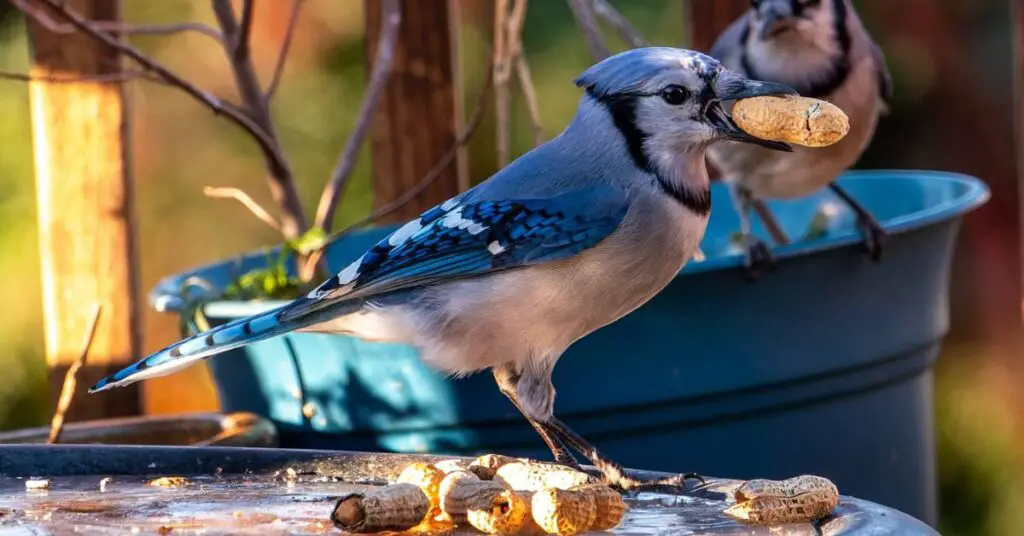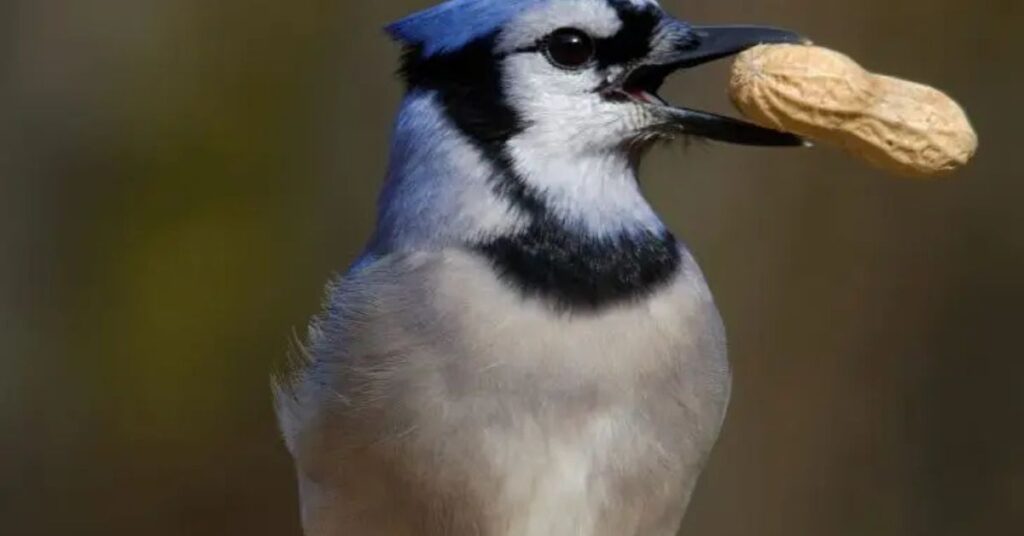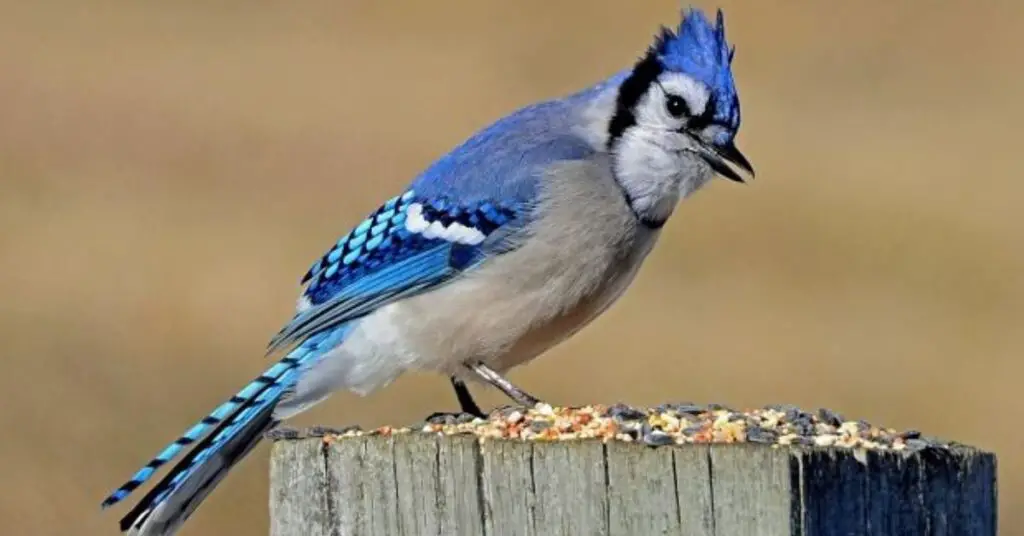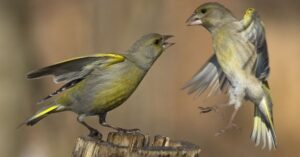If you’ve ever wondered how to attract blue jays and watched one swoop down from the treetops, you know they possess a striking beauty and an unmistakable personality that can transform any backyard into a wildlife haven.
With their energetic plumage and playful antics, these intelligent birds are not just a joy to observe; they also serve as important players in our ecosystem. But how to attract Blue Jays to your outdoor space? The answer lies in choosing the right blue jay feeder.
Setting up a dedicated blue jay bird feeder is a key step in learning how to attract Blue Jays. It can be incredibly rewarding, providing you with daily glimpses of their lively behavior while contributing to their diet. In this article, we’ll discuss the effective strategies for attracting blue jays to your yard by selecting the best feeders and offering them irresistible treats.
Blue Jays’ Favorite Foods
Blue jays are not only striking in appearance but also fascinating in their dietary preferences. So, what do blue jays eat? Their diet includes acorns, seeds, and nuts, showcasing their adaptability in the wild. These staples, they won’t shy away from insects like caterpillars and beetles or even small reptiles when available.

To attract these vibrant birds, consider setting up a bird feeder specifically designed for blue jays. Look for feeders with larger openings that accommodate their size and allow easy access to nuts and seeds—especially peanuts! Blue jays are known for their intelligence; they may even bury excess food as a way of storing it for later.
By choosing the right bird feeder for blue jays, you can transform your backyard into a bustling haven that invites these spirited avian visitors year-round while providing insights into their unique feeding behaviors.
Bird Baths And Drinking Water For Blue Jays
To attract and nourish blue jays effectively, it’s essential to consider their preferences when choosing bird feeders. Opting for bird feeders specifically designed for blue jays will significantly enhance your chances of seeing these vibrant birds in your yard.
These lively creatures favor platform feeders or large tube feeders that can accommodate their size and allow them to enjoy a variety of blue jay food options, such as peanuts and sunflower seeds. Offering mixed seed blends can also attract other songbirds while keeping the blue jays happy.
A quality bird feeders, which provides fresh drinking water is equally important for supporting the health and wellbeing of blue jays. Bird baths serve as a vital resource during hot summer days; their need for hydration increases, making these artistic installations more than just decorative elements in your garden.
Positioning a shallow bath at an appropriate height encourages safe access—another way to create an inviting haven where playfulness unfolds as they splash around. By effortlessly merging food sources with reliable drinking spots, you’ll foster a thriving environment that not only captivates the eye but also enhances the local ecosystem’s vibrancy through the joyful presence of blue jays.
Things You Should Know Before Installing A Birdbath
When considering a birdbath for your garden, it’s essential to create an environment that attracts blue jays and encourages them to visit regularly. One of the top things you should know is that these vibrant birds have particular tastes in food, and providing their favorite foods can significantly increase your chances of drawing them in.
Blue jays are keen on peanuts—both whole and shelled—so incorporating a bird feeder designed specifically for blue jays, filled with a mix of peanuts and high-quality seeds like sunflower or corn, can invite these stunning creatures to your yard.
When setting up bird feeders for blue jays, place them at varying heights to accommodate their playful nature. Different feeder designs can cater to their preferences; some love perches while others prefer feeding trays where they can easily spot potential danger.
Ensuring that your birdbath has clean water is also crucial; it serves as a vital resource not just for bathing but drinking too. By thoughtfully combining an appealing food source with accessible water paired with strategic feeder placement, you’ll create a welcoming haven for blue jays and enhance your outdoor experience.
Blue Jay Shelters
To attract blue jays to your backyard, consider incorporating elements that mimic their natural habitat. These striking birds are particularly drawn to oak trees, as they thrive on acorns. Planting a few sturdy oaks or providing an assortment of bird feeders stocked with peanuts and sunflower seeds can significantly increase your chances of enticing these colorful visitors.

Blue jays are also known for their intelligence and curiosity. By installing a birdbath with shallow water, you not only offer hydration but also a refreshing place for them to play—perfect for attracting blue jays.
Regarding the origin of blue jays, it’s fascinating how these migratory birds adapt across various regions in North America, including Oregon. Their adaptable nature allows them to thrive in diverse environments from woodlands to suburban areas.
Understanding their behaviors can enhance your attraction strategies; they often call loudly when spotting potential food sources or threats, so creating an environment rich in sounds like wind chimes might pique their interest even further.
How To Attract Blue Jays And Other Types Of Jays
Creating a blue jay bird house can be a rewarding project for avid bird watchers and nature enthusiasts. Blue jays, known for their striking plumage and intelligence, often prefer nesting in tree cavities or sheltered areas.
By designing an inviting blue jay bird house, you not only provide a safe haven for these vibrant birds but also attract other types of jays that share similar habitats. Incorporating natural materials like wood bark into your birdhouse design can mimic their native surroundings, enhancing its appeal to various species.
Understanding the blue jay origin helps us appreciate the significance of conserving their environment. Native to North America, blue jays are part of the Corvidae family, which includes other intelligent birds such as crows and ravens.
By constructing an appropriately designed blue jay bird house equipped with features like drainage holes and ventilation openings, you create not just a sanctuary for blue jays but also foster an ecosystem where different avian species can cohabitate harmoniously.
Woodhouse’s Scrub-Jay
Woodhouse’s Scrub-Jay, a dynamic cousin to the more familiar Blue Jay, is often found in arid regions where they navigate scrubby landscapes with grace. To attract these fascinating birds—and enhance your backyard birdwatching experience—consider using specialized peanut feeders for blue jays.
Offering peanuts not only draws in Blue Jays but also invites Woodhouse’s Scrub-Jay into your garden, creating an engaging mix of avian visitors. These feeders can be strategically placed in sheltered areas to provide both safety and easy access for these intelligent birds.
When setting up peanut feeders for blue jays, particularly in regions like Colorado where both species can thrive, think about pairing your feeder with natural elements such as trees or shrubs nearby. This creates a welcoming environment that encourages their exploration while providing them quick cover from predators.
California Scrub-Jay
California Scrub-Jays are known for their distinctive blue and gray plumage, but what many may overlook is their ability to attract other jay species through their lively behavior and vocalizations. By establishing a habitat rich in native plants that produce berries and acorns, you can create an inviting environment not only for California Scrub-Jays but also for other jays like the Western Blue Jay or Steller’s Jay.

These birds are naturally drawn to diverse ecosystems where food sources abound, so incorporating a variety of trees and shrubs can enhance your chances of intermingling with these vibrant avian neighbors.
Another engaging way to draw in more jays is by utilizing feeders stocked with high-quality peanuts or sunflower seeds—treats that tap into their intelligence and curious nature. California Scrub-Jays exhibit complex social behaviors, often calling out when they discover food sources; this behavior can attract others nearby looking to join the feast.
Creating horizontal structures such as low perches or birdbaths not only grants them safe spaces to forage but also encourages interaction among different species.
Steller’s Jay
Steller’s Jay, with its striking blue and black plumage, not only captivates birdwatchers but also has a unique ability to attract other species of jays. By understanding the ecological dynamics at play, enthusiasts can create an inviting environment for these beautiful avian companions.
Placing feeders stocked with nuts and seeds is a surefire way to draw in not just Steller’s Jays but also their more timid relatives like Scrub Jays or Gray Jays, which may be intrigued by the abundance of food.
Fostering a diverse habitat teeming with native plants can enhance this attraction. Incorporating berry-producing shrubs and fruit-bearing trees will entice all types of jays looking for natural snacks.
Consider laying down mulch or setting up water features; the sounds and sights created here serve as additional lures that call various jay species to congregate.
Canada Jay
Canada Jays, also known as Gray Jays or Perisoreus canadensis, are fascinating creatures that can attract a variety of other jay species to their territory. This attraction often arises from their social behavior and the food resources they provide.
When Canada Jays cache food in winter months, it creates an ecosystem where opportunities for scavenging exist, drawing in not just other jays but also diverse birds such as blue jays or even corvids like ravens. The communal dynamics fostered through these activities illustrate nature’s intricate web of relationships.
Canada Jays display behaviors that are particularly enticing during nesting seasons. Their vocalizations are not only essential for communication within their flocks but can catch the attention of neighboring jay species looking for potential mates or new opportunities.
Promoting awareness about how Canada Jays interact with other species isn’t merely academic; it encourages us to observe more deeply the ecosystems around us. Incorporating feeding stations equipped with natural foods might just unveil an unexpected tapestry of birdlife right in your own backyard.
Pinyon Jay
The Pinyon Jay, with its striking blue plumage and social behavior, serves as a fascinating example of avian interaction. Pinyon Jays exhibit a remarkable affinity for community; they often engage in cooperative feeding and communal roosting.
This collective approach not only facilitates food acquisition, particularly in pinyon pine forests where pine nuts are abundant but also attracts an array of other bird species eager to join the feast. Higher concentrations of Pinyon Jays can create vibrant hotspots for birdwatchers and nature enthusiasts alike.
In engaging with the broader ecosystem, Pinyon Jays play a crucial role as seed dispersers. Their penchant for hoarding seeds means that they unintentionally aid in forest regeneration by scattering pinyon pine seeds far and wide across the landscape. This characteristic makes them invaluable partners for future generations of these majestic trees, which thrive in drier regions amidst changing climate conditions.
If you’re looking to attract other types of jays or even various songbirds to your backyard oasis, consider planting native trees like pinyons or oaks. These species not only provide essential food sources but also create natural sheltering spaces that appeal to different birds’ nesting habits.
Mexican Jay
The Mexican Jay is not only beautiful but also an intriguing presence in the ecosystems of Mexico and parts of the United States. Attracting other types of jays to your region can ignite a fascination with these intelligent birds, as they share similar social structures and behaviors.
One effective strategy is to create an inviting habitat that resonates with the preferences of various jay species. Incorporate native trees like oaks or pines, which provide both food and nesting sites while also supporting local insect populations — a vital food source for jays.
Employing specific feeding practices can make your environment more appealing to different jays. Consider offering unsalted peanuts or specialized bird mixes that include berries and seeds favored by diverse species. By placing feeders at varying heights and ensuring they have adequate perching spaces, you increase visibility and accessibility for cautious visitors.
Green Jay
The Green Jay, with its vivid coloration and lively personality, holds a unique appeal that can attract various other bird species to your backyard. By incorporating elements like feeders filled with sunflower seeds or peanuts within your garden, the vibrant colors of the Green Jay can serve as a beacon for curious birds seeking nourishment.
Your garden can become a hub of activity, where fellow corvids and songbirds flock to compete for food resources, creating an enriching atmosphere brimming with life.

Plant native vegetation that thrives in your region; this will not only attract Green Jays but also create an ideal habitat for other species. The dense foliage offers shelter and nesting opportunities for smaller birds while drawing insects that sustain them.
As these colorful creatures interact among themselves—Green Jays often engage in social dynamics that include playful antics—they emit calls that signal their presence to others nearby.
If you enjoyed this post, you might also like another article on our site: “Blue Jay Bird: What Its Appearance Reveals About Your Life.“
Conclusion
Attracting blue jays to your backyard can be a rewarding experience that enhances your outdoor space with their vibrant colors and playful antics. By providing the right food sources, such as peanuts and sunflower seeds, and creating a welcoming environment with suitable nesting sites and water features, you can invite these beautiful birds into your garden.
Maintaining a consistent feeding schedule will help establish trust and encourage regular visits. Remember to observe their behavior from a distance to enjoy their lively interactions without causing them stress.
FAQ’s
What’s The Best Food To Attract Blue Jays?
One of the best options is to provide unsalted peanuts in the shell, as blue jays have a particular affinity for them. You can also use peanut butter spread on tree bark or feeders to entice them further. Other good choices include sunflower seeds and corn, which they enjoy nibbling on.
What Do Blue Jays Love?
They have a diverse diet that consists of nuts, seeds, fruits, and insects. They have a strong preference for acorns, which they often store for later consumption. This behavior not only helps them survive during harsher months but also contributes to forest regeneration as some of the buried acorns grow into new trees.
What Color Are Blue Jays Attracted To?
Blue jays are attracted to the color blue, which is not surprising given their own vibrant plumage. The bright colors of berries and fruits in shades of blue can signal ripeness and nutritional value, making them more appealing to these birds.
- How To Keep Bees Away From Hummingbird Feeders - March 20, 2025
- How To Attract Owls To Your Yard - March 11, 2025
- Breeding Season For Wild Birds - March 9, 2025








